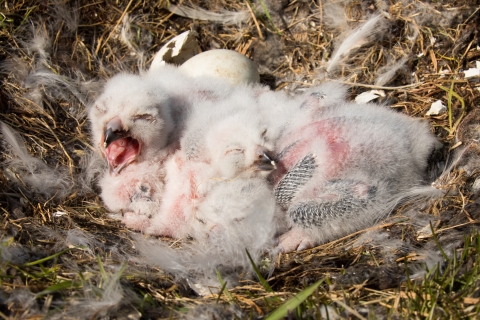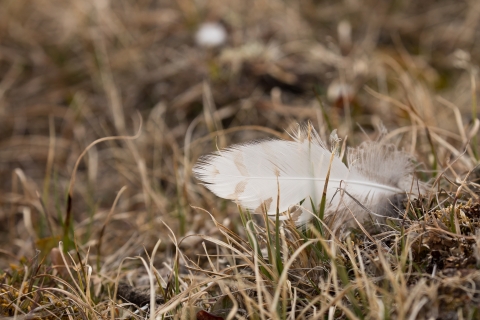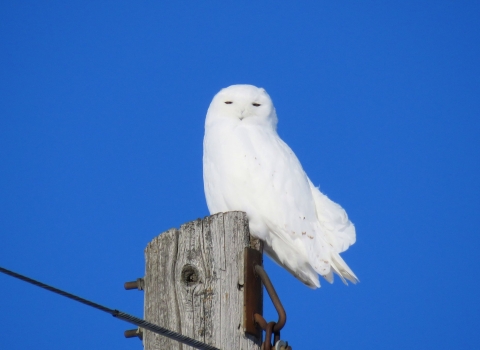A wayward Snowy Owl that made its home in the suburbs of Los Angeles from mid-December 2022 to mid-January 2023, captivated locals and people from across Southern California and beyond. The owl appeared to be doing well, despite being 3,000 miles from its typical Arctic breeding habitat. Local biologists monitored the bird, including collecting pellets to determine what it ate to make sure it’s not consuming pebbles or rocks (a sign that it’s not able to find enough food).
It’s not entirely uncommon to see Snowy Owls outside their normal winter range, which in the western hemisphere typically spans southern Alaska and boreal Canada to Greenland’s west coast. Snowy Owls are considered nomadic and irruptive migrants and can appear almost anywhere, sometimes in large numbers. However, continent-wide irruptions are rare and unpredictable. The last large Snowy Owl movement happened in the winters of 2013-2014 and 2014-2015, where an unprecedented number of Snowy Owls were found in the Northeast and Great Lakes regions, and as far south as Bermuda!
What is an irruption and what causes it? Irruptions are exceptionally large migrations where birds show up outside their typical winter range. It used to be thought that Snowy Owl irruptions were caused by hungry birds traveling in searching for food. We now know that it is better explained as an abundance of food during the previous summer causing a baby boom and therefore more owls moving south. |
Recent collaborative tracking studies on Snowy Owls has shed light on their diverse migration strategies. Some birds remain on their Arctic breeding grounds or move farther north to hunt on the sea ice, something that Indigenous peoples have known for centuries. Other individuals will migrate south predictably and regularly, while some will range sporadically farther south.
Steve Lewis, a raptor biologist with the Alaska Migratory Bird Program, spoke with the Orange County Register in January 2023 to provide expert insight to this Los Angeles visitor and the threats owls face when they show up in urban environments:
“Snowy owls are considered nomadic and, in the past, have traveled throughout the continental United States, according to a collaborative study on the winter movement ecology of Snowy Owls known as Project Snowstorm."
“They typically follow their favorite food source, lemmings, which are a small rodent found in the arctic tundra. In fact, Snowy Owls are so nomadic it led to experts miscounting how many of the species actually exist. Twenty years ago, it was believed there were 100,000, but recently it has been downgraded to about 14,000 pairs worldwide because the same birds were counted multiple times as they moved.”
Snowy Owls are listed as a Bird of Conservation Concern by the U.S. Fish and Wildlife Service. This list identifies the migratory and non-migratory bird species (beyond those already designated as federally threatened or endangered) that represent our highest conservation priorities. The Snowy Owl is also listed worldwide as ‘Vulnerable’ and 'Decreasing' by the International Union for Conservation of Nature (IUCN), with some of its threats ranging from disturbance, climate change climate change
Climate change includes both global warming driven by human-induced emissions of greenhouse gases and the resulting large-scale shifts in weather patterns. Though there have been previous periods of climatic change, since the mid-20th century humans have had an unprecedented impact on Earth's climate system and caused change on a global scale.
Learn more about climate change , shooting, trapping, and poisoning.
“A bird coming to California is pretty far and strange. Urban settings are not their thing. All the people, they’re not used to that.”
People getting too close, eating prey poisoned with rodenticide, and getting struck by cars or power lines are serious threats this individual could face.
“They don’t understand cars. They hear very well, but they don’t see well at night. If the small mammal runs out in the light and gets lit up, there it is in the light and they can see it. You often see owls out in the road because they’ve gone after something in the light.”
Luckily, the LA Snowy Owl appeared to be okay, and people enjoyed this bird from a respectable distance. Like all migratory birds, Snowy Owls are a federally protected species and disturbing them in any way, taking pellets, feathers, or other parts is illegal without a proper permit. If you ever come across an owl, be sure to follow these rules to ensure an enjoyable experience for both you and the bird.
- Observe without disturbing.
- Keep a respectful distance. In general, if it reacts to your presence, you’re too close.
- Don’t flush it, this interferes with its roosting and foraging behavior and deprives others of the opportunity to view the bird.
- Watch from your car if safe and possible.
- Move slowly and keep your voice down.
- View with the wind in your face. Birds prefer to take off into the wind, this way if it chooses to fly it will not want to fly toward you.
- Don’t lure or feed a wild owl to get a closer look.
- Never use a drone near an owl.
- Always respect private property and area-closed signs.
Behaviors to look for in a relaxed owl include ear tufts lowered but not flat; feathers held normally not contracted or expanded; upper eyelids slightly lowered; preening; stretching; sleeping; and if hunting, not looking toward you. Contrarily, stressed owls will look wide-eyed, or eyes reduced to slits; they may blink rapidly; head bobbing while looking around hastily; or wings fanned out and body feathers puffed up.
While a single incident may not seem like a life-threatening situation for an owl, it’s the cumulative effect of repeated disturbances that are more likely to occur when an owl perches in a highly visible, public location that then reduces the likelihood it will survive to return north to breed.
In Alaska we are shared stewards of world renowned natural resources and our nation’s last true wild places. Our hope is that each generation has the opportunity to live with, live from, discover and enjoy the wildness of this awe-inspiring land and the people who love and depend on it.








